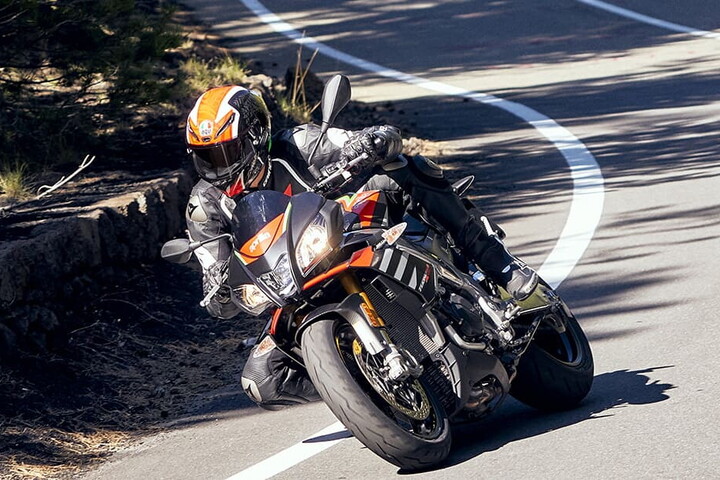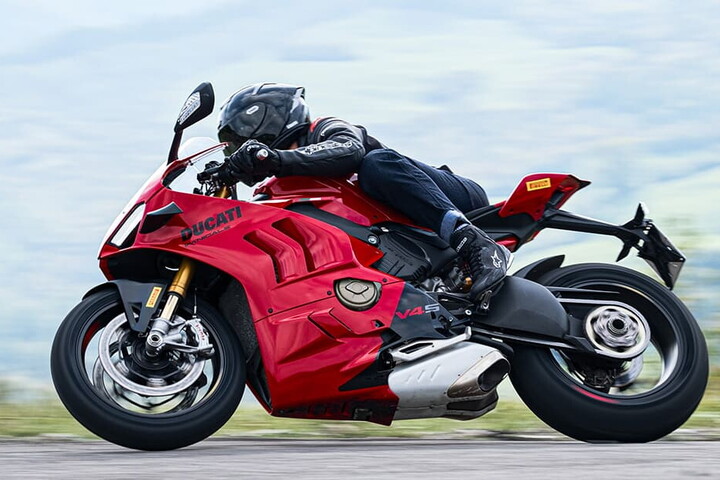To date, only part of the clothing used by motorcyclists- gloves, boots, helmets and inner layers - was required to comply with specific safety regulations.

With the introduction of European legislation, these will soon be not the only items to which conformity will apply. In the future, albeit not immediate, the certification process will be extended to the whole gamut of safety equipment and devices sold for motorcyclists.
The regulation approved by the EC will make it easier for member countries to enforce conformity with standards. The afore-mentioned regulation is much simpler to interpret as it states that all motorcycle-related clothing is part of bike kit and must, therefore, be certified.
The aim of the European Law is to protect motorcyclists and their safety in the event of an accident. Hence the objective is to certify the clothing produced for them. This procedure already exists for protective armour and a small number of garments, but will soon be extended to the full range of items, with the exception of helmets to which a specific regulation applies: ECE 22.
The standards set forth in the regulation are still being defined. Nevertheless, one thing is certain: each garment must be labelled with the certified safety level.
The safety level scale will help motorcyclists distinguish between a high-performance protective piece of clothing and a less safe one. In this way, the risk of using poor quality and unsafe products can be kept to a minimum.
It is still unknown when the law will be introduced. No doubt we will have to wait months, maybe even a year, before we can benefit from the new safety levels: the process is a relatively complex one, but one important point has undoubtedly already been established.
As soon as the law takes effect, the use of poor quality products will be banned. Above all, manufacturers of questionable provenance will be prevented from contaminating the motorcycle equipment market. All devices used on bikes are essential to protect driver and passenger safety.
A product which complies with safety regulations is a product which could make all the difference in the event of an accident. How do you recognize such a product?

Good motorcycle clothing can be vital if you fall off your bike. Unfortunately, not all protective gear on the market has what it takes to keep riders safe. Some things might look good initially but, on hitting the asphalt, they disintegrate leaving riders with no protection whatsoever.
Something to reflect on is that European regulations have been testing and certifying motorcycling kit for about ten years for this exact purpose: in order to direct users to safer models, materials and formats.
The European Association of Motorcycle Manufacturers (ACEM) examined a sample of 921 road accidents involving motorcycles. The study was called MAIDS (Motorcycle Accidents in Depth Study) and it emerged from the results that in 50% of cases, good quality kit limited injury to the body parts protected.
To know more about innovative technology for motorcycling safety, let's switch our attention to the Professor Ferdinand Porsche award: one of the most important awards for pioneering research and development work in the automotive field, endowed by Louise Piëch, daughter of professor Ferdinand Porsche. Porsche Holding, Salzburg, and Dr. Ing. h.c. F. Porsche AG, Stuttgart each provide half of the prize money.
In 2015, the prize went to Luigi Ronco, Head of Research and Development at Italian motorcycle accessory manufacturer Dainese, and Federico Sabbioni, Head of Vehicle Project Management at Italian motorcycle brand Ducati. Dainese and Ducati were awarded the Professor Ferdinand Porsche prize. It has been bestowed since 1977.

These two giants of the industry received the award for the joint development of an innovative airbag system that effectively protects motorcyclists from injury in the event of an accident. It is a truly revolutionary system and Matthias Müller, Chairman of the Executive Board of Porsche AG, underlined that, "Every airbag system fitted protects life and limb. It is a sensible investment for every motorcyclist.”
The system was built specifically to increase motorcyclist safety. The airbag contained within the jacket comprises a cartridge of condensed gas. The CO2-filled cartridge has an activation wire attached to both the bike and the cartridge.
In the event of an accident or crash, the rider would be separated from the motorcycle. When this distance is longer than the length of the wire, the movement pulls the wire out of the cartridge release system, causing the airbag to inflate.
The airbag fully inflates in three seconds. Jackets fitted with this system will absorb impacts, significantly cushioning the blow.
The trunk is protected from trauma thereby keeping all vital organs safe.
Wearing an "airbag" jacket protects the neck, spine, ribs, tailbone and collar bone.
To be designated effective, airbags in jackets must pass specific tests. These tests check that the airbags are harmless, namely there are no side effects which could injure the motorcyclist; they also check if they are effectively protective and if the activation times on impact are sufficient.
Passing these tests allows the garment to be CE-marked.
In addition to jackets, there are also airbag vests to be worn over normal motorcycle clothing, or alone to when lighter clothing is required.
To safeguard the area comprising the shoulder blades and neck, a DPS Neck systems exists. This type of protection works with the rider's helmet to reduce potentially damaging neck movements.
This inflatable collar protecting the neck should be used in conjunction with other rigid protection systems for shoulders and elbows.
Dainese has developed a product that is relatively expensive but very effective. Working with the body responsible for writing European crash test regulations for motorcycle airbags, Dainese chose to make the requirements especially stringent. In order to be deemed compliant, (which D-Air Street succeeding in doing) the safety device must pass 32 different crash tests at the manufacturing site plus all subsequent tests carried out by the certifying authority. This system increases protection of the spine by 70%, restricts head movement, protects collarbones and thorax and reduces movement of the helmet in the event of rolling. In the event of powerful impact, it activates in just 0.45 seconds: it is the fastest protective system on the market.
The D-air system made its debut in 2007 at the MotoGP world championship. Since then, it has been assimilated and incorporated into all Dainese rider suits. The D-Air Misano 1000 has integrated electronic control incorporated into the rider's suit.
This new type of protective clothing does not need sensors on the bike to work properly. The sensors, electronics and GPS system are contained within the back armour. The airbag has a special integral network of micro-wires allowing it to inflate evenly across the surface, in some cases to widths of up to 5cm. The Misano 1000 jacket has a chest and back protector which protect the chest, back and collarbone and also the neck from over-extending or hypertension.
Sensors monitor what the rider is doing 800 times a second and, depending on the gravity of the situation, decide if and when to activate the system. This control of body parts can also be disabled, if need be, using a switch hidden inside the garment.
All motorcycle clothing can already be CE-marked. To obtain this certification, jackets, gloves, trousers, boots and safety guards must pass very stringent tests; this is why there are so few manufacturers. At present, CE-marking is only mandatory for protective devices, so for shoulders, elbows and back, and for boots, if they are sold as motorcyclist boots. It is essential that the afore-mentioned devices are quality-certified but the degree of safety they provide is severely impaired, or even destroyed, if they are inserted inside non-conforming and poor quality garments.
Poor quality products are unable to keep the safety devices they contain in place; very often all it takes is the slightest movement for their effectiveness to be severely reduced.
To tell the difference between a conforming product from one that is not, check the label. Remember, though, that the EC mark alone is not enough. Indeed, many motorcycling garments carry the CE mark with little further explanation. This is misleading because the CE mark should also be accompanied by the symbol for the associated regulation.
Let's take a look at certification marks.
EN13595-1-2-3-4 covers everything, suits, trousers and jackets. Clothing of this kind, when certified, provide two levels of protection. Level 1 indicates a garment that will remain intact for at least four seconds in the event of a fall at 50km/h. Level 2 indicates a garment that will remain intact for at least seven seconds in the event of a fall at 110 km/h.
EN1621-1 regards the degree to which body armour in motorcycling clothing absorbs impacts. Body armour refers to the guards used to protect elbows, shoulders and knees.
EN 1621-2 regulates back protectors. In the same way as protective clothing, this regulation also provides two levels of protection for use when riding in the city or on open roads.
EN 13594 regulates gloves. Glove testing requires them to remain intact for at least 2.5 seconds. In the event of abrasion, this time must elapse before they come apart.
Boots are regulated by EN13634 which was recently updated. All boots marketed specifically by the manufacturer for motorcycles must be CE-marked. There are two levels of protection for boots: the first level requires the boots to withstand abrasion for at least 5 seconds before opening, whereas the second level of certification sets this time at 12 seconds.
Certified clothing items are tested to see when they give way and how they perforate. As regards perforation, the depth at which a knife blade manages to penetrate at a given pressure is measured. Other checks are performed regarding the comfort of the garment, the PH of the materials used and how well they withstand chemicals. PH controls are very important in determining the acidity of materials coming into direct contact with the body. This applies in particular to leather clothing: leather tanning and manufacturing can alter the acidity and make it harmful. The products used could trigger allergic skin reactions in riders who can only tolerate a given degree of acidity or alkalinity. What's more, all garments must be supplied with instructions for proper use, maintenance and to understand when they should be replaced, as well as a statement regarding the non-toxicity of the materials.
Other essential information include special environmental conditions in which some forms of armour should not be used, such as the back protector, which at very high temperatures may be less effective.




